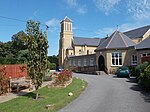Spithead

Spithead is an area of the Solent and a roadstead off Gilkicker Point in Hampshire, England. It is protected from all winds except those from the southeast. It receives its name from the Spit, a sandbank stretching south from the Hampshire shore for 5 km (3.1 mi). Spithead is 22.5 km (14.0 mi) long by about 6.5 km (4.0 mi) in average breadth. Spithead has been strongly defended since 1864 by four Solent Forts, which complement the Fortifications of Portsmouth. The Fleet Review is a British tradition that usually takes place at Spithead, where the monarch reviews the massed Royal Navy. The Spithead mutiny occurred in 1797 in the Royal Navy fleet at anchor at Spithead. It is also the location where HMS Royal George sank in 1782 with the loss of more than 800 lives.
Excerpt from the Wikipedia article Spithead (License: CC BY-SA 3.0, Authors, Images).Spithead
Geographical coordinates (GPS) Address External links Nearby Places Show on map
Geographical coordinates (GPS)
| Latitude | Longitude |
|---|---|
| N 50.7514 ° | E -1.13667 ° |
Address
Spithead
PO33 1ND
England, United Kingdom
Open on Google Maps









